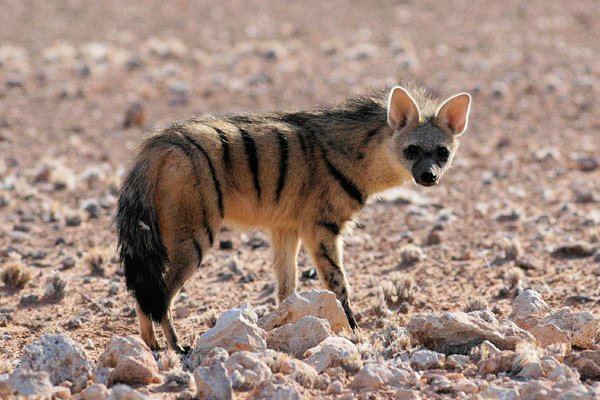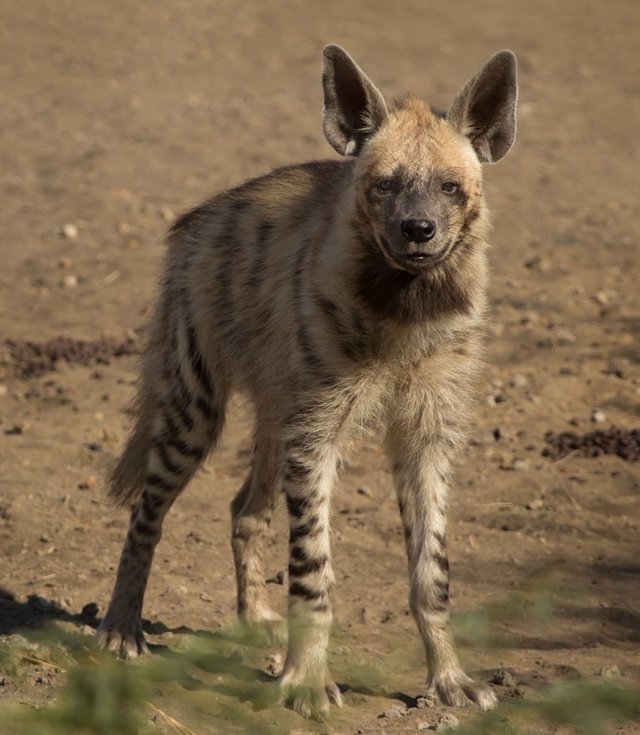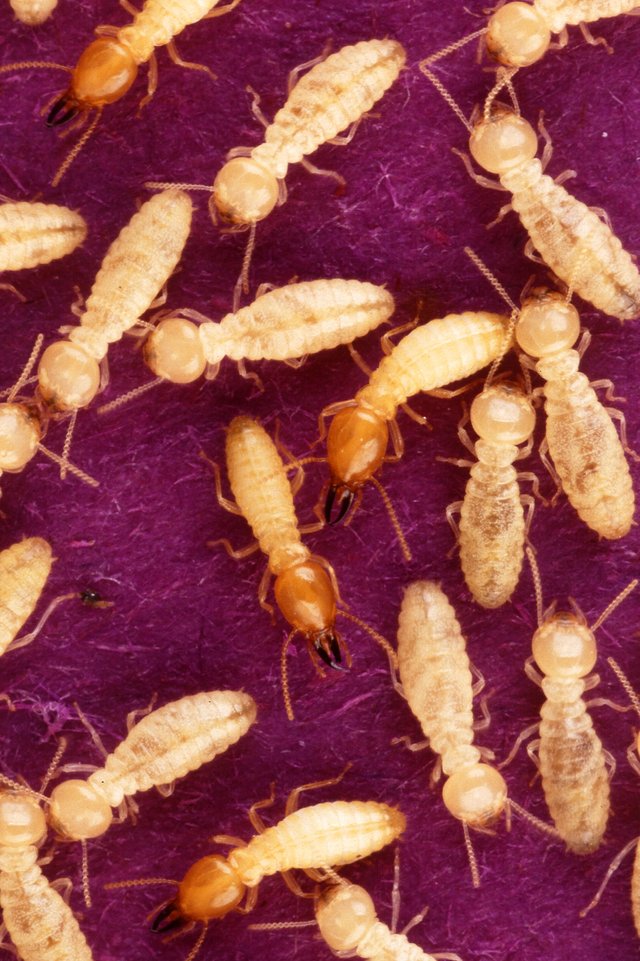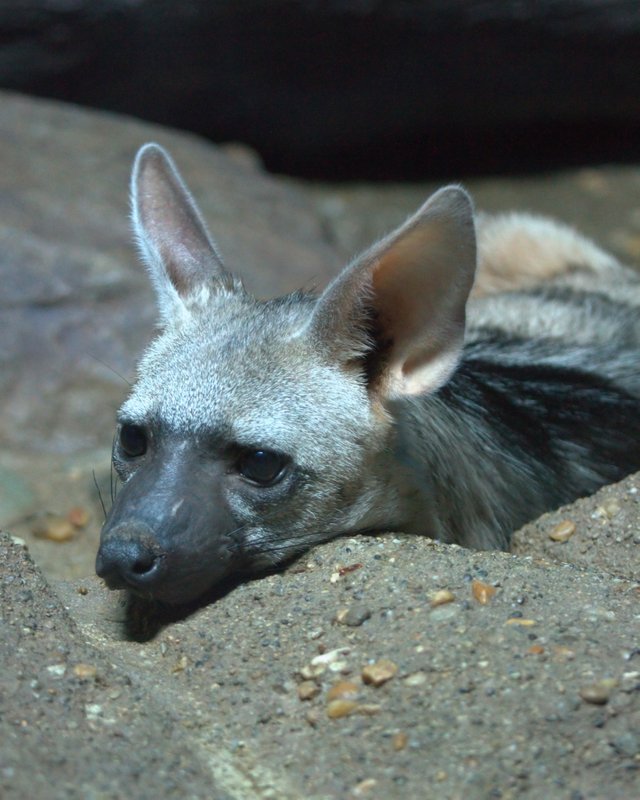The aardwolf (Proteles cristata) is a species of hyena that does not hunt large animals, but instead eats about 250,000 termites each night!
I’m sure you all think of a big, scary predator when you hear the word hyena, and for the most part this is correct. There is however more than just one species of hyena, and in this post I want to tell you a little bit about the diversity found within this family of “cat-like” animals.

An image of an aardwolf, a very interesting species of hyena! Image by Dominik Käuferle, posted with the Creative Commons Attribution-Share Alike 3.0 Unported license.
Let me start of by explaining why I wrote them as being “cat-like”. I know that for some reason many people think the hyenas are closely related to the dogs and wolves, but this is incorrect. They are all in the order Carnivora, just like both cats and dogs, but the hyenas are actually part of the suborder Feliformia. This suborder would literally be translated into “cat-like”, and includes animals such as mongooses, meerkats, civets, and the true cats (family Felidae) such as tigers, cats, lions and so on. There is also another suborder called Caniformia (dog-like) that include wolves, raccoons, foxes and even bears and some seal species, but not hyenas. Anyway, let’s return to the hyenas again!
The hyenas (Hyaenidae sp.) is a small taxonomic family with only four extant species. All four of these are endemic to Africa and parts of the Middle-East, and only the striped hyena (Hyaena hyaena) is found outside of Africa. Despite being evolutionary closely related to cats, the hyenas are both behaving and looking a lot more like canines than cats, which is a very good example of convergent evolution; meaning here that since there are no big canines on the African continent, another species filled this open spot in the ecosystem to exploit this untapped niche. This lead to evolve to behave a lot like wolves, since there was en ecological vacancy for this type of behavior.

A striped hyena. Image by Sumeet Moghe, posted with the Creative Commons Attribution-Share Alike 3.0 Unported license.
As I said, there are only 4 living species of hyenas, but this does not mean that they are not diverse. The striped hyena are mostly scavengers, but the spotted hyenas on the other hand kill up to 95 % of their own food, leaving only a small portion of their diet for scavenging. The most remarkable species of hyena is the aardwolf (Proteles cristata), which is not killing big mammals at all!
The aardwolf is an insect eater!
The aardwolf is very different from the other three hyena species, with the biggest difference being that it does not hunt or scavenge large animals at all. Instead of a very powerful bite it got a long, sticky tongue that is perfect for eating insects, and its favorite is termites (Infraorder Isoptera). During a single night the aardwolf is able to eat about a quarter of a million termites by itself, which is obviously a huge number even considering the fact that termites are very small.

Termites; the favorite food of aardwolves! Image is Public Domain.
It only feeds during the night, while sleeping at day, so it’s very rare to see an aardwolf with your own eyes even if you visit the shrublands of eastern and southern Africa. It looks a lot like the striped hyena, and for a while scientists believed that it was simply an animal that had copied the traits of the morphology of the hyena without being a member of the hyena species itself.
Despite eating insects and larvae, the aardwolf still has its hyena teeth, and can use these for defense, as well as for fighting with other aardwolves about territory or mating, but they are not really good at fighting when they have to defend their territory against other animal species. They are very territorial, and mark their territory by extruding a black substance from their anal glands. A single territory is controlled by a monogamous pair, and potentially a few offspring that are still young enough to live with their parents.

An aardwolf up close and personal. Photo by Greg Hume, posted with the Creative Commons Attribution-Share Alike 3.0 Unported license.
Conservation status of the aardwolf and other hyenas
The aardwolf has a very low population density since it needs lots of termites in its territory, so you generally only find a single pair on a one square kilometer big area. Despite this the population is considered stable, and it is classified Least Concern by the IUCN. The spotted hyena (Crocuta crocuta) is in the same boat, and is also considered Least Concern, but sadly both the Brown hyena and the Striped hyena are having a decline in their population numbers, and are considered Near Threatened.
This means that no of the four hyena species is in immediate threat of extinction, but at this point we should keep a watchful eye on both the brown and the striped hyena to prevent further population loss.
Thanks for reading
Thank you very much for reading my posts about hyenas, and the aardwolf in particular. I hope you enjoyed it!
As for the sources of the aardwolf, a lot of is it taken from the book African Predators by Gus Millis and Martin Harvey. This is a very nice book to read if you are at all interested in the large predators of Africa. As for the other sources, the links are found spread in the post close to where the information I found from them are, so check it out to learn more!
Great post.
I've seen one of these in the wild in the Kruger National Park in South Africa. They are definitely less scary than Hyenas and feels like a cross between what we call a bakoorjakkals (aka jackal with scientific name Otocyon megalotis) and a Hyena.
Their name "Aardwolf" in my native language Afrikaans, directly translates to Earth Wolf!
Keep exploring... Jaco
Thank you for this comment, @extremejogging! It's so nice when people with first hand experience are able to chime in with additional information to my posts ;)
It's funny that you should point out that their are translated into earth wolf, because the Norwegian name for them (jordulv) will also translate directly into earth wolf.
I have to admit that I never heard of this animal. Nothing more to add than your blog is a great source of learning, and one of the best blogs on Steemit. Keep up the good work :)
It's not a very common animal to know about, @dieterschneider, so it is not so strange that you hadn't heard of it before :) And thank you very much for all these kind words!
The aardwolf sounds sort of similar to the aardvark, in that they are both mostly nocturnal and eat termites (though I think aardvarks also eat ants). Thank you for bringing this interesting animal to our attention!
Yeah, they are a lot like each other, but they are in no way related to each other when looking at phylogenetics. As far as I understook, aard means earth in Afrikaans.
Thanks for stopping by and leaving a comment, @calathea!
A near cat becoming a near wolf due to an ecological niche just shows how amazing natural selection is and how we all evolve to our environments.
Busy little guys! Picking up 250 000 of anything in one night would be hard work
Yeah, it's really cool that species evolve to fill all the vacant niches. We see most of this in Australia where marsupials have evolved to fill most of the niches themselves, from small rodent-like animals to big predators. -
And also they like resting in burrows during the day.
I guess their tongue gets very tired after such a dinner...
Oh yeah, they must have some pretty big muscles in the tongues compared to us humans.
Wow, another story of aardwolf, first time hearing this, and your post really give a full details on it. Seriously without your post, I would have refer this animal as a wolf because of the suffix wolf. Which mean I will be total wrong lolz
@valchiz
Hehe, yeah, it surely looks like a type of wolf. Thanks for stopping by, @valchiz!
aardwolf eat 0.25 million termite. big number but the number contains only 2.5-3.0 kg weight so not a big deal for aardwolf. I see termite colony every where around my surroundings. I wonder how many termites are there. may be in trillions or zillions.
Yeah, that's a good point, @kamchore. 0.25 million sounds like a lot, but each termites is very small, so I guess the termite colony has no problem with this. However, there's far from trillions, and the best estimations I could find from a quick Google search was that a colony might have a few million each.
Your point of view is valid. The best idea is to count the colony of termite instead of counting termite.
You may want to check the latest post on @amavi on hyenas too ;)
Thanks for the upvote and suggestion, @lemouth! @amavi is definitely a skilled writer that I will follow from now on :)
:)
It's quite obvious that they will be extinct soon because they aren't adding any value to humans as such. We humans are selfish beings. But hopefully something will fix it. Somehow. Someway.
Hehe, that's a bit pessimistic of you, but I can understand why you think this way. I also hope we are able to do something at one point, and the priority should be to stop deforestation and reduce emission in my opinion. Anyway, thanks for the comment, @adityabhat!
What a diet to be on! 8-)
Haha, yeah, that's a pretty unique diet! I wonder how long it spends on eating all these; sadly I was nota ble to find that out. Thanks for stopping by, @orcdu! How is it going?
I always stop by, I just don't comment a lot 8-). Things are fine, photography is a bit slow though because of drab weather and lack of creatures frolicking about. And you?
Ah, that's nice to hear, @orcdu! I understand what you mean; winter can be pretty long and boring for those of us who enjoy all the organisms we find at summer.